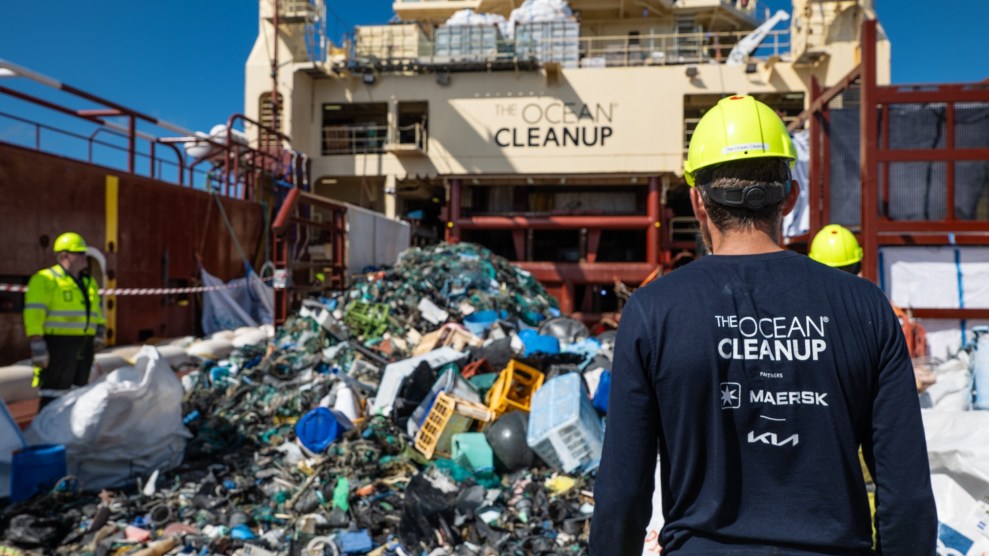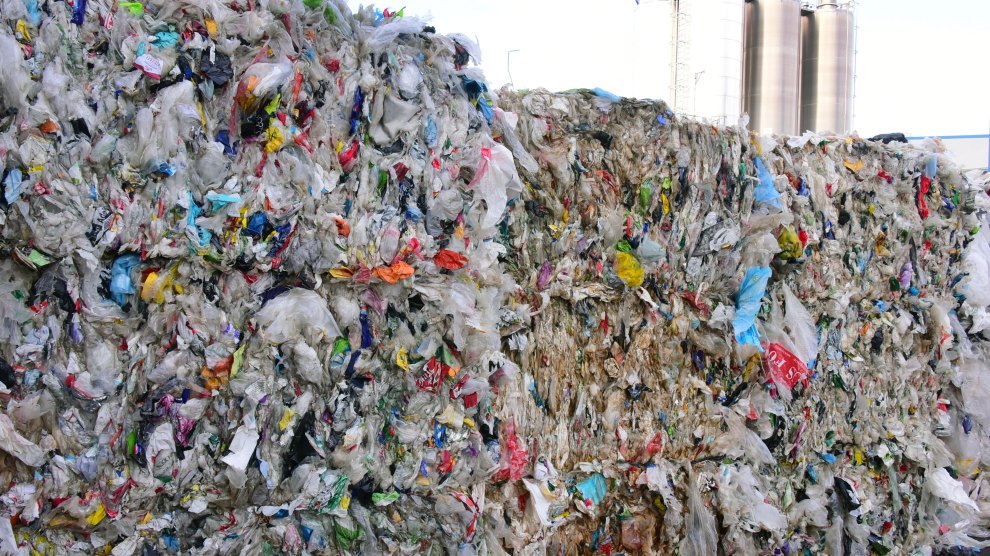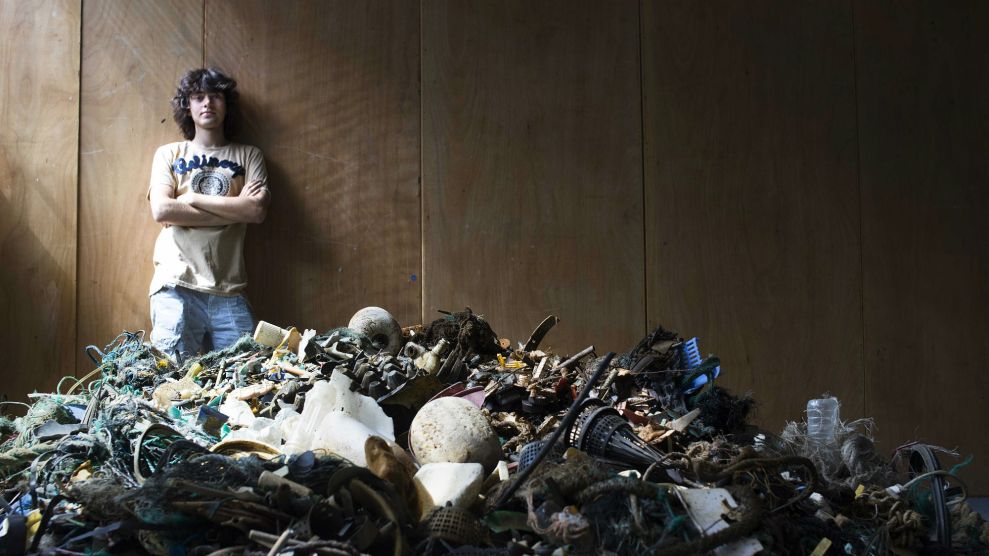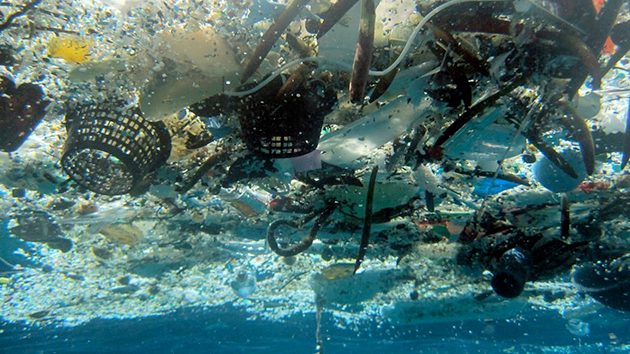
Workers for environmental nonprofit, The Ocean Cleanup. Cover Images/ZUMA
This story was originally published by Slate and is reproduced here as part of the Climate Desk collaboration.
Rebecca Helm despises the phrase “Great Pacific Garbage Patch.”
This moniker is used to describe the vast stretch of ocean from the West Coast of North America to Japan that is crammed with an estimated 1.8 trillion pieces of trash, most of which are plastic.
“I think it’s a really awful practice to name a part of the world after something bad that’s happened to it,” says Helm, a marine biologist at Georgetown University’s Earth Commons Institute.
Moreover, she thinks that this term misleadingly implies that this area is a barren wasteland, when in fact there is a trove of marine life living alongside the floating plastic bottles, dirty fishing nets, and discarded Styrofoam cups. Along with the occasional shark or sea turtle passerby, this region—which is actually called “the North Pacific High”—hosts a unique array of tiny species that live at the sea surface, from electric-blue seadragons to minuscule snails that ride bubbles like rafts across the open ocean.
However, the life teeming in this area poses a complex conundrum for groups trying to clean it up.
Currently, there are a variety of companies and organizations operating devices to extract pollution from the open ocean, including the Ocean Cleanup, a nonprofit that uses a 1.4-mile net-like screen connected to two ships to slowly skim the water’s surface and collect plastic in the North Pacific High.
While removing ocean plastic is important, Helm says, she worries about how this technology is affecting the assemblage of marine life living at the ocean’s surface, which is known collectively as the neuston. She outlined her concerns about the Ocean Cleanup in a 2019 op-ed published by The Atlantic, writing that “we cannot monitor this ecosystem with our current technology, and millions of animals may die and dissolve before the scale of destruction is fully understood.”
The Ocean Cleanup published a response to her piece on their website, rebutting several of her claims. However, several years later, Helm still believes that we don’t understand enough about the environmental impacts of the Ocean Cleanup and other ocean plastic removal technologies on the market—and she isn’t the only one.
This past November, Helm and a group of international marine experts published a commentary outlining the fallacy of these ocean cleanup devices. It came out one week ahead of the latest round of the United Nations plastics negotiations in Nairobi, where more than 175 countries gathered to discuss a global treaty to deal with the plastic problem.
The commentary further highlighted potential risks to biodiversity, mainly from bycatch—the accidental capture of marine life. But the authors also questioned removal technologies’ effectiveness at cleaning up plastic at a meaningful scale. For example, one study suggests that it would take 200 devices from the Ocean Cleanup, running for 130 years, to capture just 5 percent of the world’s floating plastics, which would release a significant amount of carbon emissions.
“If the bathtub is overflowing, you turn off the tap first before you start mopping the floor,” says Melanie Bergmann, a biologist at the Alfred Wegener Institute in Germany and lead author on the commentary. “If you put more and more plastics into the system, it’s a Sisyphean task; you will never be able to clean it all up.”
But the Ocean Cleanup has a different philosophy: “It’s not an either-or,” says Matthias Egger, the head of environmental and social affairs at the Ocean Cleanup. “We see ourselves as a temporary project. You cannot clean up indefinitely if you do not also address the source of the problem, but we need to do both.”
The organization was founded in 2013 by 16-year-old Boyan Slat, a Dutch inventor and entrepreneur, with the aim of cleaning up 90 percent of floating ocean plastic pollution by 2040. Currently, the Ocean Cleanup is only operating one plastic retrieval system, which goes on periodic six-week trips to the North Pacific. But their goal is to eventually scale up to 10 devices, powered by 20 ships. Egger says they use computational models to help predict where the highest concentrations of plastic are in this area, like a “weather forecast button for plastic.”
Though it’s likely the most well-known device, the Ocean Cleanup isn’t the only plastic removal game in town. A bevy of devices have flooded the market in recent years—from floating garbage bins that filter out debris, developed by Australian company Seabin, to a water drone created by Dutch company RanMarine that skims the sea surface autonomously and chomps up plastic bits. In many ways, eliminating plastic from the ocean can improve habitat quality and benefit ocean species by reducing the risk of plastic entanglement or ingestion, which kills 100,000 marine animals each year, according to a report from Earth.Org.
But these devices could also hurt the very ecosystems that they are trying to protect. In 2023, the Ocean Cleanup’s operations captured more than 335,000 pounds of plastic. However, from July 2021 until December 2023, the system also caught 2,866 pounds of incidental bycatch, including fish, mollusks, crustaceans, and barnacles, according to a report from the organization. A 2022 study performed by the University of Plymouth on a Seabin at a tidal marina in the United Kingdom found that for every four pieces of plastic the device snatched, one organism was also caught; 73 percent of the organisms that were caught were dead after two days.
While this pales in comparison to the level of bycatch from nets used by the fishing industry, the commentary’s authors state that the amount of marine life unintentionally caught by plastic removal technology is still harming ecosystems, and that the long-term impacts of these devices are still not yet entirely understood.
“Before we start to roll out things that purport to be solutions, it’s absolutely essential that we’ve got clear, independent scientific evidence to guide us so that we know that those solutions are actively effective and that they’re not simply making the problem worse,” says Richard Thompson, a marine researcher at the University of Plymouth and co-author on the Seabin study, as well as the recent commentary.
In response to biodiversity risks, including the ones outlined in Thompson’s report, the Seabin team recently pivoted its business model from selling the devices to users around the world to focusing operations on heavily populated cities, using Sydney’s harbor in Australia as a pilot.
Here, the company runs daily servicing and collection of trash in their own units.
“It turned into a huge liability because we didn’t know where the Seabins were being sold,” says Pete Ceglinski, the CEO and co-founder of Seabin. They started buying back Seabins in 2020, though there are still many units out there that they were unable to retrieve, Ceglinski says. Now, the company’s revenue comes from corporate and government clients, which pay to help operate the machines and are able to tell their customers that they support plastic removal efforts, he adds.
Seabin has not conducted or commissioned an environmental impact assessment for its devices, a common and problematic trend for plastic-removal technology companies, according to Bergmann. The Ocean Cleanup, on the other hand, does commission its own environmental impact assessments each time it develops a new model, conducted by marine consulting firm CSA Ocean Sciences. As the nonprofit has developed new iterations of its system, it has added measures to try to minimize bycatch, such as underwater cameras and green LED lights to increase visibility of the equipment.















